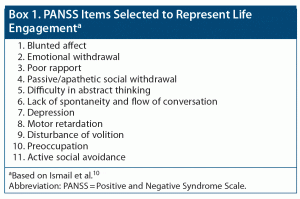See more Academic Highlights in this series: Part 1 | Part 3
This Academic Highlights section of The Journal of Clinical Psychiatry presents the highlights of the virtual roundtable “Patient Functioning and Life Engagement: Unmet Needs in MDD and Schizophrenia,” which was held May 10, 2022.
The roundtable was chaired by Christoph U. Correll, MD, Zucker School of Medicine at Hofstra/Northwell, Hempstead, New York, and Charité Universitätsmedizin, Berlin, Germany. The faculty were Zahinoor Ismail, MD, Department of Psychiatry, Hotchkiss Brain Institute, Cumming School of Medicine, University of Calgary, Calgary, Alberta, Canada; Roger S. McIntyre, MD, Mood Disorder Psychopharmacology Unit, University Health Network, Department of Psychiatry, University of Toronto; Institute of Medical Science, University of Toronto; and Departments of Psychiatry and Pharmacology, University of Toronto, Toronto, Ontario, Canada; Roueen Rafeyan, MD, Department of Psychiatry, Feinberg School of Medicine, Northwestern University, Chicago, Illinois; and Michael E. Thase, MD, Department of Psychiatry, Perelman School of Medicine of the University of Pennsylvania, and the Corporal Michael J. Crescenz Veterans Affairs Medical Center, Philadelphia, Pennsylvania.
Financial disclosures: Please refer to the first Academic Highlights in this series: Correll CU, Ismail Z, McIntyre RS, et al. Patient functioning and life engagement: unmet needs in major depressive disorder and schizophrenia. J Clin Psychiatry. 2022;83(4):LU21112AH1 (https://doi.org/10.4088/JCP.LU21112AH1)
This evidence-based peer-reviewed Academic Highlights was prepared by Healthcare Global Village, Inc. Financial support for preparation and dissemination of this Academic Highlights was provided by H. Lundbeck A/S and Otsuka Product Development and Commercialization. The faculty acknowledges Sarah Brownd, MA, ELS, for editorial assistance in developing the manuscript. The opinions expressed herein are those of the faculty and do not necessarily reflect the views of Healthcare Global Village, Inc., the publisher, or the commercial supporters. This article is distributed by H. Lundbeck A/S and Otsuka Product Development and Commercialization for educational purposes only.
J Clin Psychiatry 2022;83(5):LU21112AH2
To cite: Correll CU, Ismail Z, McIntyre RS, et al. Patient functioning, life engagement, and treatment goals in schizophrenia. J Clin Psychiatry. 2022;83(5):LU21112AH2
To share: https://doi.org/10.4088/JCP.LU21112AH2.
© 2022 Physicians Postgraduate Press, Inc.
Unmet needs in the treatment of schizophrenia include nonadherence to treatment, symptom relapse, incomplete functional recovery, and poor quality of life. Incorporating the patient’s perspective into the treatment plan and measuring treatment outcomes that are meaningful to patients is an important part of addressing these issues. Goal setting is associated with greater improvements in motivation and role functioning,1 but clinicians should keep in mind that their goals for treatment may not align with those of their patients. Patients tend to think about their lives more holistically than clinicians, with equal weight given to social and clinical needs,2 and improved functioning and engagement with life are likely to emerge as priorities, beyond the need for symptom control.
In a recent roundtable meeting, a panel of 5 experts discussed life engagement and its relationship to symptoms and functioning in patients with major depressive disorder (MDD) and schizophrenia. This Academic Highlights, part 2 in a series, summarizes the experts’ discussion of how life engagement can inform goal-setting and treatment selection in patients with schizophrenia.
INCORPORATING THE PATIENT’S PERSPECTIVE WHEN PLANNING TREATMENT
Clinicians and patients should agree on treatment choice (ie, shared decision making), but arriving at these choices involves a process with discussion of the benefits and risks. To ensure this communication takes place effectively, patients and clinicians should first reach concordance on the goals of treatment.3 Listening to the patient’s perspective enables treatment selection and planning to be tailored to the individual, facilitating positive outcomes.4 As Bridges et al3 argue, emphasis on concordance can also help combat paternalism with regard to decision making in health care.
Evidence shows that patients have the capacity to weigh treatment pros and cons and to communicate their own priorities and goals.5,6 Dr Ismail emphasized that clinicians should not underestimate their patients’ ability to articulate their own lived experience regarding life engagement:
Initiating patient-centric discussions around life engagement in patients with schizophrenia can also help build therapeutic alliance. Dr Rafeyan explained that when the clinician effectively connects with the patient and lets them know that they are the patient’s “biggest fan,” this can help put patients at ease about psychiatric treatment in general. “Especially in schizophrenia, we often hear patients express, ‘I don’t want to be a zombie’: that’s the mental image they have about psychiatric treatment.” Incorporating discussion of functional and life engagement goals early on can help set the patient’s mind at ease about psychiatric treatment and clarify that in addition to symptom amelioration, the ultimate goal is for them to lead a full, engaged life over which they feel in control. Such reassurance could be helpful with regard to future treatment adherence and thus better clinical outcomes.
ASSESSING LIFE ENGAGEMENT IN PATIENTS WITH SCHIZOPHRENIA
The roundtable participants discussed possible pros and cons of incorporating life engagement as a measurable treatment goal when formulating treatment plans. According to Dr Ismail, there are very few situations in which it would not be beneficial to measure life engagement. He said that in the vast majority of patients across the treatment spectrum, it is incumbent on clinicians—and a fundamental part of care—to consider the patient’s voice and engagement. He stated that his practice has evolved to incorporate life engagement assessment on a day-to-day basis, and he has created his own patient-rated measure of quality of life, functioning, and engagement that his patients fill out in the waiting room: “It’s very instructive in terms of how they’re feeling, what they’re doing, their satisfaction, and what’s important to them. And it’s a great secondary source of information on top of the self-report and clinician-rated scales that we collect and measure, providing a really holistic understanding of how someone’s doing and what they want to be doing.” Dr Correll added that having patients complete even a short assessment could be valuable without taking too much appointment time. Dr Rafeyan relayed that to get a sense of a patient’s engagement level, he questions them (and their caregiver, if applicable) about how much excitement they’re currently feeling about their lives in general, about socializing with their family and others, and about upcoming events or activities.
In terms of barriers to assessing life engagement, Dr Thase cited the lack of scales with which to measure it. Measures such as the Personal and Social Performance scale (PSP)7 have been used to assess social functioning (eg, socially useful activities, self-care), and parts of other instruments such as the Positive and Negative Syndrome Scale (PANSS)8 capture elements of life engagement, but there is currently no specific life engagement scale, but there is currently no specific scale capturing all aspects of it.9 In lieu of such a measure, a recent analysis10 used the PANSS to provide insight into life engagement and to explore treatment effects using existing data. A group of experts in treating schizophrenia (which included participants in the current roundtable) used a modified Delphi process to select 11 items from the 30-item PANSS that captured patient engagement and well-being beyond improvement of the core symptoms of schizophrenia (Box 1). These 11 items were then applied in a post hoc analysis of pooled data from clinical trials in schizophrenia. Principal component analysis showed that changes in the grouped items clustered together, suggesting that life engagement is a measurable outcome and that these 11 items serve as a good proxy for measuring it.10

PSYCHOSOCIAL AND OTHER FACTORS IMPACTING IMPROVEMENT
Patient factors predating treatment, such as the patient’s cognition, motivation level, and degree of positive symptoms, impact their capacity for improvement in functioning and life engagement.11 As Dr Ismail commented, “One’s own baseline condition is usually the limit.” To personalize treatment, clinicians must take these individual factors into account. It was acknowledged that nonclinical factors including psychosocial stressors may be ultimately beyond clinicians’ control, and addressing them is an ongoing challenge. Dr Ismail stressed that for improvement to occur, the basic social determinants of health must be addressed: Can we ensure that someone is in an environment that is safe and secure and that they have a place to sleep, and food, and access to health care? These form a foundation on which pharmacotherapeutic and other interventions can then be effectively implemented.
Drs McIntyre and Rafeyan emphasized the importance of encouraging exercise and healthy dietary and sleep habits, as they have benefits not just for physical health but also for functioning and, potentially, life engagement. In fact, as Dr Rafeyan pointed out, schizophrenia is linked to inflammation,12,13 which can be reduced through healthy diet and exercise.
LIFE ENGAGEMENT AND CURRENT TREATMENT OPTIONS
How can life engagement inform initial treatment selection and later modifications? The participants felt that even in the early stages, life engagement can be incorporated as a treatment goal. Dr Rafeyan explained that individual patients’ goals can shape treatment selection; for example, a patient who wishes to return to school will want to avoid sedation and needs good cognitive function.
Patients should be made aware from the beginning that different medications may need to be tried before the best one for them is identified.14 Clinical decisions made at early stages can impact later outcomes, and, according to Dr Ismail, keeping that in mind is a part of addressing life engagement. Side effects, such as activating and sedating side effects and weight gain, can negatively impact functioning and quality of life.15 Selecting an agent with a tolerable side effect profile, he said, can therefore improve a patient’s ability to function and to engage with life later. A clinician might make a priori decisions anticipating that the patient will want to avoid those side effects. Ultimately, however, the patient’s voice must be heard, and that happens over time in conjunction with symptom improvement.
Mechanisms of action relevant to life engagement. It was agreed that engaging mechanisms beyond the traditional dopamine blockade of first- and second-generation antipsychotics is key. As Dr Ismail put it, “We want the appropriate dopaminergic blockade with ancillary mechanisms that allow reduction in hallucinations and delusions and stabilization of mood and that avoid the neuroleptic ‘dysphoria’ that we’ve tolerated for so many years…a medication that allows them to think and be generative and creative and yet be safe and avoid the degree of psychosis that might impair their ability to live independently and to have agency.”
Three dopamine receptor partial agonist antipsychotic medications with multimodal mechanisms have been approved by the US Food and Drug Administration for the treatment of schizophrenia: aripiprazole, brexpiprazole, and cariprazine. These dopamine partial agonists are distinct from earlier D2-blocking medications. They are less likely to cause weight gain than some second-generation agents,16 and their more moderate histaminergic activity17,18 versus olanzapine and quetiapine19 means that they are less sedating. Although the lower potential for sedation is a plus for life engagement, the degree of intrinsic D2 and D3 activity seen with aripiprazole and cariprazine, respectively, may lead to activating effects that can cause restlessness or akathisia in some patients.20,21
A variety of antipsychotics has been shown to improve social functioning in patients with schizophrenia,22 and all 3 approved dopamine partial agonists have demonstrated improvements in PSP scores.23–25 Brexpiprazole has demonstrated promising results with regard to life engagement in particular. Unsolicited feedback to the manufacturer from health care providers and patient call centers suggested that patients appeared to be more engaged with life after taking brexpiprazole.26 The post hoc analysis described earlier9 suggested that brexpiprazole improved well-being and life engagement in addition to its effects on core schizophrenia symptoms; 10 of the 11 PANSS life engagement items showed improvement versus placebo (P < .05).10 Further, while improvements in life engagement were accompanied by improvements in functioning,27 the effect of the medication on life engagement appears to be direct and not entirely mediated by its effects on symptoms and functioning.28
 Patient Perspectives
Patient Perspectives
Here, patients with schizophrenia or MDD and their family members describe improved engagement with life after brexpiprazole treatment in spontaneous calls made to the drug manufacturer’s call center29:
“He can actually be around people for the first time”
“Positive, motivated, happy, and happy to see other people happy”
“I had my first real conversation about 3 months ago”
“Makes me feel like I have a life”
“I have energy. I could think. I felt like me”
Psychosocial interventions. Psychosocial and other nonpharmacologic interventions are essential elements of a multifaceted approach to schizophrenia treatment and the journey toward recovery.30–32 Therapies supported by evidence include assertive community treatment, family psychoeducation, illness self-management training, and social skills training.32 In terms of increasing life engagement, Dr Thase commented that psychotherapies can help create behavioral activation, which in turn can help people commit to engaging in social and physical activities that put them in a position to experience connectivity, joy, contact, recreation, movement—all contributors to well-being. For some patients, he said, the psychotherapy “pull” can engage the individual into the process of feeling better.
Finally, Dr Correll issued clinicians the goal of aiming high and instilling hope in their patients with schizophrenia. He emphasized not to give up early, and that the action of setting goals can actually move patients toward the goals, because they are now able to visualize the outcomes. This reflects an upward-moving process rather than a downward spiral in which the patient assumes a sick role: rather than thinking, “I am a schizophrenic,” they think, “I have an illness.” He concluded by highlighting society’s responsibility to provide structure and resources for patients to engage in their lives even when they are not at their best, and through that engagement, they can become more and more functional.
CLINICAL POINTS
- Clinicians should elicit patients’ individual goals for their lives and incorporate them into the treatment plan where possible.
- Initiating conversations about a patient’s engagement with life and monitoring it on an ongoing basis can strengthen the therapeutic alliance and provide insights about the patient’s progress toward recovery.
- Along with psychosocial interventions, dopamine receptor partial agonist medications that avoid sedation and certain other side effects may be a good option to maximize functioning and life engagement in patients with schizophrenia.
Published online: August 17, 2022.
References (32)

- Fulford D, Meyer-Kalos PS, Mueser KT. Focusing on recovery goals improves motivation in first-episode psychosis. Soc Psychiatry Psychiatr Epidemiol. 2020;55(12):1629–1637. PubMed CrossRef
- Klein E, Rosenberg J, Rosenberg S. Whose treatment is it anyway? the role of consumer preferences in mental health care. Am J Psychiatr Rehabil. 2007;10(1):65–80. CrossRef
- Bridges JFP, Slawik L, Schmeding A, et al. A test of concordance between patient and psychiatrist valuations of multiple treatment goals for schizophrenia. Health Expect. 2013;16(2):164–176. PubMed CrossRef
- Keepers GA, Fochtmann LJ, Anzia JM, et al; (Systematic Review). The American Psychiatric Association Practice Guideline for the treatment of patients with schizophrenia. Am J Psychiatry. 2020;177(9):868–872. PubMed CrossRef
- Bridges JF, Kinter ET, Schmeding A, et al. Can patients diagnosed with schizophrenia complete choice-based conjoint analysis tasks? Patient. 2011;4(4):267–275. PubMed CrossRef
- Kinter ET, Schmeding A, Rudolph I, et al. Identifying patient-relevant endpoints among individuals with schizophrenia: an application of patient-centered health technology assessment. Int J Technol Assess Health Care. 2009;25(1):35–41. PubMed CrossRef
- Morosini PL, Magliano L, Brambilla L, et al. Development, reliability and acceptability of a new version of the DSM-IV Social and Occupational Functioning Assessment Scale (SOFAS) to assess routine social functioning. Acta Psychiatr Scand. 2000;101(4):323–329. PubMed CrossRef
- Kay SR, Fiszbein A, Opler LA. The positive and negative syndrome scale (PANSS) for schizophrenia. Schizophr Bull. 1987;13(2):261–276. PubMed CrossRef
- McIntyre RS, Ismail Z, Watling CP, et al. Patient-reported outcome measures for life engagement in mental health: a systematic review. J Patient Rep Outcomes. 2022;6(1):62. PubMed CrossRef
- Ismail Z, Pedersen AM, Thase ME, et al. Effect of brexpiprazole on engagement in patients with schizophrenia: post-hoc analysis of three studies. Schizophr Bull. 2020;46(suppl 1):S208–S209. CrossRef
- Mucci A, Galderisi S, Gibertoni D, et al; Italian Network for Research on Psychoses. Factors associated with real-life functioning in persons with schizophrenia in a 4-year follow-up study of the Italian Network for Research on Psychoses. JAMA Psychiatry. 2021;78(5):550–559. PubMed CrossRef
- Fond G, Lançon C, Korchia T, et al. The role of inflammation in the treatment of schizophrenia. Front Psychiatry. 2020;11:160. PubMed CrossRef
- Fendrich SJ, Koralnik LR, Bonner M, et al. Patient-reported exposures and outcomes link the gut-brain axis and inflammatory pathways to specific symptoms of severe mental illness. Psychiatry Res. 2022;312:114526. PubMed CrossRef
- Hasan A, Falkai P, Wobrock T, et al; WFSBP Task force on Treatment Guidelines for Schizophrenia. World Federation of Societies of Biological Psychiatry (WFSBP) guidelines for biological treatment of schizophrenia, part 2: update 2012 on the long-term treatment of schizophrenia and management of antipsychotic-induced side effects. World J Biol Psychiatry. 2013;14(1):2–44. PubMed CrossRef
- Tandon R, Lenderking WR, Weiss C, et al. The impact on functioning of second-generation antipsychotic medication side effects for patients with schizophrenia: a worldwide, cross-sectional, web-based survey. Ann Gen Psychiatry. 2020;19(1):42. PubMed CrossRef
- Pillinger T, McCutcheon RA, Vano L, et al. Comparative effects of 18 antipsychotics on metabolic function in patients with schizophrenia, predictors of metabolic dysregulation, and association with psychopathology: a systematic review and network meta-analysis. Lancet Psychiatry. 2020;7(1):64–77. PubMed CrossRef
- de Bartolomeis A, Tomasetti C, Iasevoli F. Update on the mechanism of action of aripiprazole: translational insights into antipsychotic strategies beyond dopamine receptor antagonism. CNS Drugs. 2015;29(9):773–799. PubMed CrossRef
- Maeda K, Sugino H, Akazawa H, et al. Brexpiprazole I: in vitro and in vivo characterization of a novel serotonin-dopamine activity modulator. J Pharmacol Exp Ther. 2014;350(3):589–604. PubMed CrossRef
- Richelson E, Souder T. Binding of antipsychotic drugs to human brain receptors focus on newer generation compounds. Life Sci. 2000;68(1):29–39. PubMed CrossRef
- Mohr P, Masopust J, Kopeček M. Dopamine receptor partial agonists: do they differ in their clinical efficacy? Front Psychiatry. 2022;12:781946. PubMed CrossRef
- Citrome L. Activating and sedating adverse effects of second-generation antipsychotics in the treatment of schizophrenia and major depressive disorder: absolute risk increase and number needed to harm. J Clin Psychopharmacol. 2017;37(2):138–147. PubMed CrossRef
- Huhn M, Nikolakopoulou A, Schneider-Thoma J, et al. Comparative efficacy and tolerability of 32 oral antipsychotics for the acute treatment of adults with multi-episode schizophrenia: a systematic review and network meta-analysis. Lancet. 2019;394(10202):939–951. PubMed CrossRef
- Fleischhacker WW, Baker RA, Eramo A, et al. Effects of aripiprazole once-monthly on domains of personal and social performance: results from 2 multicenter, randomized, double-blind studies. Schizophr Res. 2014;159(2–3):415–420. PubMed CrossRef
- Németh G, Laszlovszky I, Czobor P, et al. Cariprazine versus risperidone monotherapy for treatment of predominant negative symptoms in patients with schizophrenia: a randomised, double-blind, controlled trial. Lancet. 2017;389(10074):1103–1113. PubMed CrossRef
- Correll CU, He Y, Therrien F, et al. Effects of brexpiprazole on functioning in patients with schizophrenia: post hoc analysis of short- and long-term studies. J Clin Psychiatry. 2022;83(2):39942. PubMed CrossRef
- Weiss C, Meehan SR, Brown TM, et al. Effects of adjunctive brexpiprazole on calmness and life engagement in major depressive disorder: post hoc analysis of patient-reported outcomes from clinical trial exit interviews. J Patient Rep Outcomes. 2021;5(1):128. PubMed CrossRef
- Meehan SR. Shi L, Pedersen A, et al. Effects of brexpiprazole on patient engagement and functioning in schizophrenia. Presented at the Annual Meeting of the American Society of Clinical Psychopharmacology. May 29, 2020; Miami, FL.
- Meehan SR, He Y, de Jong Laird A, et al. Path analyses to explore the direct and indirect effects of brexpiprazole on life engagement: post hoc analysis of six clinical studies in depression and schizophrenia. Presented at the American Society of Clinical Psychopharmacology Annual Meeting. June 1, 2021.
- Thase ME, Pedersen A, Ismail Z, et al. Efficacy of adjunctive brexpiprazole in adults with MDD: improvement of patient engagement based on selected items from the Inventory of Depressive Symptomatology Self-Report (IDS-SR) scale. Presented at the 32nd Annual Psych Congress. October 3, 2019; San Diego, CA.
- Lahera G, Gálvez JL, Sánchez P, et al. Functional recovery in patients with schizophrenia: recommendations from a panel of experts. BMC Psychiatry. 2018;18(1):176. PubMed CrossRef
- Vita A, Barlati S. Recovery from schizophrenia: is it possible? Curr Opin Psychiatry. 2018;31(3):246–255. PubMed CrossRef
- Mueser KT, Deavers F, Penn DL, et al. Psychosocial treatments for schizophrenia. Annu Rev Clin Psychol. 2013;9(1):465–497. PubMed CrossRef
This PDF is free for all visitors!




